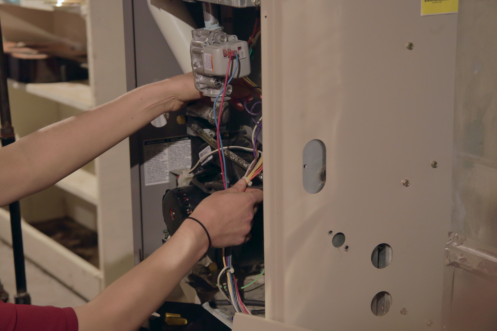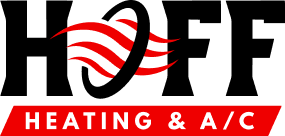What Does Dual Fuel Furnace Mean?

While there are many ways to heat your O’Fallon, MO home, few offer the efficiency and flexibility of a dual-fuel furnace. Also known as hybrid heating systems, dual-fuel furnaces combine natural gas furnaces and electric heat pumps. As needed, they seamlessly toggle between the two to maintain comfortable indoor conditions with minimal input. Whether you’re interested in lowering your carbon footprint or your home energy bill, opting for a dual-fuel furnace is an excellent way to reach your goal.
The Benefits and Drawbacks of Natural Gas Heating
Natural gas furnaces are the top choice for winter heating in regions like O’Fallon where outside temperatures regularly dip and remain below freezing. Natural gas is clean burning and available at a reasonable cost.
Gas furnaces produce heat with temperatures as high as 140 degrees Fahrenheit. This allows for rapid heating and also ensures that the cold air seeping through cracks and gaps in building materials or the heat that escapes when residents enter or exit the building doesn’t completely diminish the heat gains. Unfortunately, despite these and other attributes, natural gas furnaces have come under fire in recent years due to their greenhouse gas emissions. All fuel-burning appliances produce carbon monoxide (CO) and other exhaust gases as the result of incomplete combustion. Greenhouse gases take a cumulative toll on the natural environment. According to the United States Environmental Protection Agency (EPA), they act like a blanket that slows or prevents heat loss to space and contributes to global warming.
Many states, counties, and cities throughout the nation have banned natural gas heaters or introduced legislation to ban them in the future. However, Missouri has banned all natural gas heating bans and kept gas-fired furnaces as a viable option for consumers.
In O’Fallon, dual-fuel heating systems provide the perfect compromise between efficiency and environmental sustainability. They allow homeowners to use natural gas heating when it’s the most efficient heating source while instantly transitioning to electric heating when outdoor conditions make a heat pump even more efficient.
The Benefits and Drawbacks of Using Heat Pumps for Heating
You can find high-efficiency gas furnaces with annual fuel utilization efficiency (AFUE) ratings of 98.5%. With tightly sealed combustion chambers, secondary heat exchangers, and other design improvements, these appliances turn 98.5% of the fuel they consume into usable heat and lose just 1.5% as emissions.
Rather than burning fuel to produce heat, electric heat pumps leverage a highly efficient heat transfer process. The refrigerant-filled coils absorb heat from outdoor air and release it indoors. During summer, heat pumps are functionally identical to air conditioners and transfer indoor heat outside.
While natural gas-fired furnaces can have AFUE ratings of 80% to 98.5%, the efficiency levels for heat pumps are often off the charts. In ideal operating conditions, some heat pumps can produce three to four times as much heating and cooling energy as they consume in electric energy. This makes them 300% to 400% efficient.
The major drawback of using a heat pump as a sole heating source is the fact that some air-source units progressively lose efficiency when outdoor temperatures fall below freezing. With temperatures in O’Fallon often holding steady at just 20 degrees Fahrenheit, an air-source heat pump will often prove less efficient than even an entry-level gas furnace.
During long stretches of below-freezing weather, some air-source heat pumps have an increasingly hard time sourcing enough outside heat to bring indoors. This leads to longer and less productive heating cycles, increased wear, and higher energy bills. It can also cause outdoor heat pump coils to ice over and freeze. During times of extreme weather, relying solely on an air-source heat pump for heating could lead to a home heating emergency.
Throughout the nation, electricity rates are much higher than the price of natural gas. They’re also more volatile. Pair this with the fact that some models of air-source heat pumps will use extraordinary amounts of electricity when the weather is at its coldest, and exclusively using a heat pump for heating is by far the most costly choice.
Another drawback of using a heat pump for heating in extremely cold weather is the fact that these systems produce low, steady heat. While natural gas furnaces can burn as hot as 140 degrees Fahrenheit, the heat from a heat pump tops out at just 90 degrees. Although this is significantly warmer than most building interiors, it’s also slightly lower than the human body temperature. Thus, your living space won’t feel as toasty with a heat pump, and envelope-related heat losses could prove more noticeable.
Dual-fuel Furnaces Offer the Best of Both Worlds
Natural gas furnaces provide economical and reliable heating in chilly winter climates, but even the best of these appliances produce harmful greenhouse emissions during operation. To limit your carbon footprint, you can switch to a heat pump when outdoor temperatures are above freezing and when heat pump efficiency is at its highest. A dual-fuel furnace will curb both your electricity and gas use without requiring manual input from you. During fall and early spring when temperatures are chilly but still moderate, you may even be able to eliminate greenhouse gas production entirely.
Dual-fuel Furnace Systems Also Provide Cooling
The term “dual-fuel furnace” is actually a bit of a misnomer. While these systems do offer two fuel types via two seamlessly integrated heating systems, they also provide summertime cooling. Thus, installing a dual-fuel furnace eliminates the need to install and maintain a separate air conditioner. Best of all, heat pumps are more efficient than furnaces when operating conditions are ideal and significantly more efficient than standard central air conditioners. Choosing this heating system type will allow for year-round energy savings without any losses in comfort or convenience.
Add Value to Your Home
HVAC system electrification is currently ranked among the best ways to protect the natural environment from greenhouse gases and global warming. After all, HVAC system use accounts for about half of the average homeowner’s energy bill. However, it’s important to consider the environmental and economic drawbacks of all-electric heating in cold-weather areas like O’Fallon. Upgrading your HVAC system to a dual-fuel furnace that offers superior levels of efficiency all of the time could greatly increase your home’s marketability and value. Savvy home buyers are increasingly looking for smart, efficient upgrades like these.
Enjoy Better Humidity Regulation
Having an electric heat pump as an alternative to forced air natural gas heating can provide better humidity control. For instance, while running a natural gas heater during mild weather can leave building interiors overly dry, the radiant heat a heat pump produces won’t.
We help homeowners in O’Fallon, MO make informed decisions about their heating and cooling equipment. We offer exceptional furnace, heat pump, and air conditioner installation, maintenance, and repairs. We also provide advanced indoor air quality solutions, mechanical ventilation, geothermal heating, and preventative maintenance plans. To find out more about dual-fuel furnaces or to schedule an appointment, contact Hoff Heating & AC now.

 Call Us Today
Call Us Today
